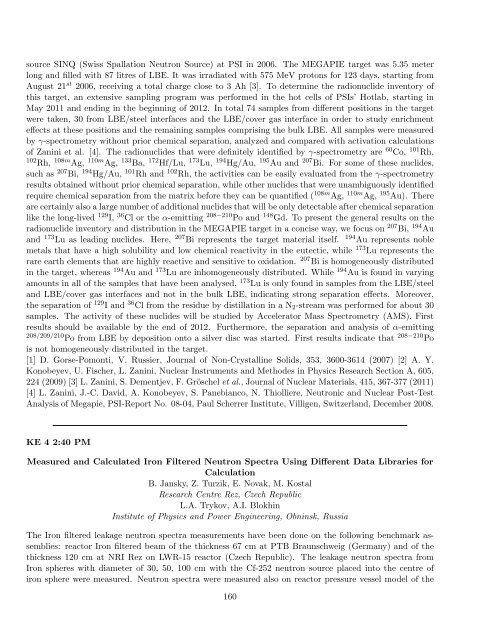Program - Brookhaven National Laboratory
Program - Brookhaven National Laboratory
Program - Brookhaven National Laboratory
Create successful ePaper yourself
Turn your PDF publications into a flip-book with our unique Google optimized e-Paper software.
source SINQ (Swiss Spallation Neutron Source) at PSI in 2006. The MEGAPIE target was 5.35 meter<br />
long and filled with 87 litres of LBE. It was irradiated with 575 MeV protons for 123 days, starting from<br />
August 21st 2006, receiving a total charge close to 3 Ah [3]. To determine the radionuclide inventory of<br />
this target, an extensive sampling program was performed in the hot cells of PSIs’ Hotlab, starting in<br />
May 2011 and ending in the beginning of 2012. In total 74 samples from different positions in the target<br />
were taken, 30 from LBE/steel interfaces and the LBE/cover gas interface in order to study enrichment<br />
effects at these positions and the remaining samples comprising the bulk LBE. All samples were measured<br />
by γ-spectrometry without prior chemical separation, analyzed and compared with activation calculations<br />
of Zanini et al. [4]. The radionuclides that were definitely identified by γ-spectrometry are 60Co, 101Rh, 102Rh, 108mAg, 110mAg, 133Ba, 172Hf/Lu, 173Lu, 194Hg/Au, 195Au and 207Bi. For some of these nuclides,<br />
such as 207Bi, 194Hg/Au, 101Rh and 102Rh, the activities can be easily evaluated from the γ-spectrometry<br />
results obtained without prior chemical separation, while other nuclides that were unambiguously identified<br />
require chemical separation from the matrix before they can be quantified ( 108mAg, 110mAg, 195Au). There<br />
are certainly also a large number of additional nuclides that will be only detectable after chemical separation<br />
like the long-lived 129I, 36Cl or the α-emitting 208−210Po and 148Gd. To present the general results on the<br />
radionuclide inventory and distribution in the MEGAPIE target in a concise way, we focus on 207Bi, 194Au and 173Lu as leading nuclides. Here, 207Bi represents the target material itself. 194Au represents noble<br />
metals that have a high solubility and low chemical reactivity in the eutectic, while 173Lu represents the<br />
rare earth elements that are highly reactive and sensitive to oxidation. 207Bi is homogeneously distributed<br />
in the target, whereas 194Au and 173Lu are inhomogeneously distributed. While 194Au is found in varying<br />
amounts in all of the samples that have been analysed, 173Lu is only found in samples from the LBE/steel<br />
and LBE/cover gas interfaces and not in the bulk LBE, indicating strong separation effects. Moreover,<br />
the separation of 129I and 36Cl from the residue by distillation in a N2-stream was performed for about 30<br />
samples. The activity of these nuclides will be studied by Accelerator Mass Spectrometry (AMS). First<br />
results should be available by the end of 2012. Furthermore, the separation and analysis of α-emitting<br />
208/209/210Po from LBE by deposition onto a silver disc was started. First results indicate that 208−210Po is not homogeneously distributed in the target.<br />
[1] D. Gorse-Pomonti, V. Russier, Journal of Non-Crystalline Solids, 353, 3600-3614 (2007) [2] A. Y.<br />
Konobeyev, U. Fischer, L. Zanini, Nuclear Instruments and Methodes in Physics Research Section A, 605,<br />
224 (2009) [3] L. Zanini, S. Dementjev, F. Gröschel et al., Journal of Nuclear Materials, 415, 367-377 (2011)<br />
[4] L. Zanini, J.-C. David, A. Konobeyev, S. Panebianco, N. Thiolliere, Neutronic and Nuclear Post-Test<br />
Analysis of Megapie, PSI-Report No. 08-04, Paul Scherrer Institute, Villigen, Switzerland, December 2008.<br />
KE 4 2:40 PM<br />
Measured and Calculated Iron Filtered Neutron Spectra Using Different Data Libraries for<br />
Calculation<br />
B. Jansky, Z. Turzik, E. Novak, M. Kostal<br />
Research Centre Rez, Czech Republic<br />
L.A. Trykov, A.I. Blokhin<br />
Institute of Physics and Power Engineering, Obninsk, Russia<br />
The Iron filtered leakage neutron spectra measurements have been done on the following benchmark assemblies:<br />
reactor Iron filtered beam of the thickness 67 cm at PTB Braunschweig (Germany) and of the<br />
thickness 120 cm at NRI Rez on LWR-15 reactor (Czech Republic). The leakage neutron spectra from<br />
Iron spheres with diameter of 30, 50, 100 cm with the Cf-252 neutron source placed into the centre of<br />
iron sphere were measured. Neutron spectra were measured also on reactor pressure vessel model of the<br />
160
















